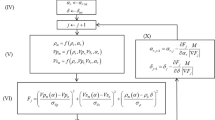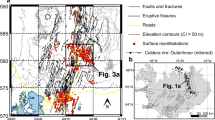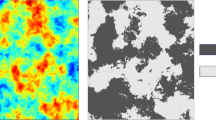Abstract
The chemical zoning profile in metamorphic minerals is often used to deduce the pressure–temperature (P–T) history of rock. However, it remains difficult to restore detailed paths from zoned minerals because thermobarometric evaluation of metamorphic conditions involves several uncertainties, including measurement errors and geological noise. We propose a new stochastic framework for estimating precise P–T paths from a chemical zoning structure using the Markov random field (MRF) model, which is a type of Bayesian stochastic method that is often applied to image analysis. The continuity of pressure and temperature during mineral growth is incorporated by Gaussian Markov chains as prior probabilities in order to apply the MRF model to the P–T path inversion. The most probable P–T path can be obtained by maximizing the posterior probability of the sequential set of P and T given the observed compositions of zoned minerals. Synthetic P–T inversion tests were conducted in order to investigate the effectiveness and validity of the proposed model from zoned Mg–Fe–Ca garnet in the divariant KNCFMASH system. In the present study, the steepest descent method was implemented in order to maximize the posterior probability using the Markov chain Monte Carlo algorithm. The proposed method successfully reproduced the detailed shape of the synthetic P–T path by eliminating appropriately the statistical compositional noises without operator’s subjectivity and prior knowledge. It was also used to simultaneously evaluate the uncertainty of pressure, temperature, and mineral compositions for all measurement points. The MRF method may have potential to deal with several geological uncertainties, which cause cumbersome systematic errors, by its Bayesian approach and flexible formalism, so that it comprises potentially powerful tools for various inverse problems in petrology.







Similar content being viewed by others
References
Bishop CM (2006) Pattern recognition and machine learning. Springer, New York
Geman D, Geman S, Graffigne C, Dong P (1990) Boundary detection by constrained optimization. IEEE Trans Patt Anal Mach Intell 12(7):609–628
Geman S, Geman D (1984) Stochastic relaxation, Gibbs distributions, and the Bayesian restoration of images. IEEE Trans Patt Anal Mach Intell 6(6):721–741
Hodges KV, McKenna LW (1987) Realistic propagation of uncertainties in geologic thermobarometry. Am Miner 72(7–8):671–680
Holland TJB, Powell R (1998) An internally consistent thermodynamic data set for phases of petrological interest. J Metamorph Geol 16(3):309–343
Inui M, Toriumi M (2002) Prograde pressure-temperature paths in the pelitic schists of the Sambagawa metamorphic belt, SW Japan. J Metamorph Geol 20(6):563–580
Kohn MJ, Spear FS (1991) Error propagation for barometers. 1. Accuracy and precision of experimentally located end-member reactions. Am Miner 76(1–2):128–137
Kohn MJ, Spear FS (1991) Error propagation for barometers. 2. Application to rocks. Am Miner 76(1–2):138–147
Kohn MJ (1993) Uncertainties in differential thermodynamic (Gibbs method) P–T paths. Contrib Miner Petrol 113(1):24–39
Kretz R (1983) Symbols for rock-forming minerals. Am Miner 68(1–2):277–279
Metropolis N, Rosenbluth AW, Rosenbluth MN, Teller AH, Teller E (1953) Equation of state calculations by fast computing machines. J Chem Phys 21(6):1087–1092
Miyoshi S, Okada M (2011) Image Restoration and segmentation using region-based latent variables: Bayesian inference based on variational method. J Phys Soc Jpn 80(1):014802. doi:10.1143/JPSJ.80.014802
Okamoto A, Toriumi M (2001) Application of differential thermodynamics (Gibbs’ method) to amphibole zonings in the metabasic system. Contrib Mineral Petrol 141(3):268–286
Spear FS, Rumble D (1986) Pressure, temperature, and structural evolution of the Orfordville belt, west-central New-Hampshire. J Petrol 27(5):1071–1093
Spear FS, Selverstone J (1983) Quantitative P–T paths from zoned minerals: theory and tectonic applications. Contrib Miner Petrol 83(3–4):348–357
Spear FS, Menard T (1989) Program Gibbs: a generalized Gibbs method algorithm. Am Miner 74(7–8):942–943
Spear FS (1993) Metamorphic phase equilibria and pressure-temperature-time paths. Mineralogical Society of America, Washington, DC
Takiyama K, Katahira K, Okada M (2009) Exact inference in discontinuous firing rate estimation using belief propagation. J Phys Soc Jpn 78(6):064003. doi:10.1143/JPSJ.78.064003
Watanabe K, Tanaka H, Miura K, Okada M (2009) Transfer matrix method for instantaneous spike rate estimation. IEICE Trans Inf Syst E92D(7):1362–1368
Acknowledgments
We thank the editors and two anonymous reviewers for constructive comments that improved an earlier version of this manuscript. We also thank Mutsuko Inui and Atsushi Okamoto for helpful discussions. This study was supported by the research project "Evaluation and disaster prevention research for the coming Tokai, Tonankai and Nankai earthquakes" from the Ministry of Education, Culture and Sports, Science and Technology of Japan.
Author information
Authors and Affiliations
Corresponding author
Additional information
Communicated by J. Blundy.
Appendix
Appendix
It is essential to estimate the precise P–T path that the hyperparameters, \(\sigma_{1n}^2, \sigma_{2n}^2, \sigma_{Pm}^2,\) and \(\sigma_{Tm}^2, \) are determined. This is the most important advantage of the Bayesian approach. The hyperparameters, \(\sigma_{1n}^2, \sigma_{2n}^2, \sigma_{Pm}^2, \) and \(\sigma_{Tm}^2,\) can also be regarded as random thermodynamic variables. Then, we need to determine the set of hyperparameters that maximize the posterior probability \(p(\sigma_{1n}^2, \sigma_{2n}^2, \sigma_{Pm}^2,\sigma_{Tm}^2 |\{ X_{1}^i \} ,\{ X_{2}^i \} ) . \) Using Bayes’ theorem,
Here, the following equation has mathematical equality:
This type of operation is referred to as marginalization. We define the negative logarithm of the posterior possibility as the free energy function using Eqs. 19 and 20 as
where \(E(\{ P^i \} ,\{ T^i \},\sigma_{1n}^2,\sigma_{2n}^2,\sigma_{Pm}^2 ,\sigma_{Tm}^2)\) is the evaluation function defined by Eq. 16, and C is a constant independent of \(\sigma_{1n}^2, \sigma_{2n}^2, \sigma_{Pm}^2, \) and \(\sigma_{Tm}^2.\)
In order to search the set of hyperparameters that minimize \(F(\sigma_{1n}^2, \sigma_{2n}^2, \sigma_{Pm}^2,\sigma_{Tm}^2), \) the steepest decent method was used in the present study. The slope of the free energy F to the hyperparameter σ2 can be expressed as
where \(\langle g\rangle _{h} \) indicates the expectation value of g for the probability distribution h. This type of equation can be written for every hyperparameter. Hence, the calculation of the gradients of the free energy F to the hyperparameters results in the calculation of the expectation values of \(\partial E/\partial \sigma^2\) for the posterior probability distribution \(p(\{ P^i \} ,\{ T^i \} |\{ X_{1 }^i \} ,\{ X_{2 }^i \} ). \) In the present study, the Metropolis algorithm, which is a type of MCMC method, was used to numerically calculate the expectation value (Metropolis et al. 1953). In the algorithm, numerous candidate sets of {P i} and {T i} are generated to produce the posterior probability distribution \(p(\{ P^i \} ,\{ T^i \} |\{ X_{1 }^i \} ,\{ X_{2 }^i \} ).\) Consequently, the MAP and PM solutions of {P i} and {T i} can be simultaneously obtained in the process of hyperparameter estimation.
Rights and permissions
About this article
Cite this article
Kuwatani, T., Nagata, K., Okada, M. et al. Precise estimation of pressure–temperature paths from zoned minerals using Markov random field modeling: theory and synthetic inversion. Contrib Mineral Petrol 163, 547–562 (2012). https://doi.org/10.1007/s00410-011-0687-3
Received:
Accepted:
Published:
Issue Date:
DOI: https://doi.org/10.1007/s00410-011-0687-3




